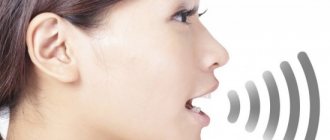The structure of the speech apparatus
The physiological basis of speech is the subtle mechanism of interaction between its two departments - central and peripheral.
The central part of the speech apparatus is located in several structures of the brain:
- Wernicke's center is located in the temporal part of the left hemisphere, where the analysis and discrimination of sounds, their quantity and order of sound in words occurs.
- Broca's center (inferior frontal gyrus, its posterior third) - through nerve impulses, controls the work of the speech muscles, due to which their movements are smooth and consistent, as well as control of their position.
- The subcortical nuclei create the basis for the formation of innate vocal reflexes, on the basis of which voluntary speech is formed. The subcortical nuclei of the extrapyramidal system regulate the functioning of the speech muscles. The smoothness of speech, its pace and emotionality, and the pitch of the voice are realized by the subcortical-cerebellar nuclei.
- Coordination of movements and muscle tone of the vocal, respiratory and articulatory departments is ensured by the work of the cerebellum.
- The brain stem innervates the organs of the peripheral part of the speech apparatus.
The peripheral department includes three departments:
- respiratory (provides both physiological and specific speech breathing);
- vocal, or phonation - forms the voice;
- articulatory - produces speech sounds.
The physiological basis of the method of speech development believes that many causes of speech defects are the result of disturbances in the structure and interaction of the central and peripheral parts of the speech apparatus.
Digital library
Sciences about man and society / Human physiology / 8.8. Speech and its mechanisms
Speech -
the highest function of the central nervous system, an important mechanism of intellectual activity, a form of human communication.
Types of speech:
1. visible
(written) – associated with the work of the temporal and parietal lobes of the brain;
2. audible
(oral) – connected with the temporal (speech understanding) lobe of the left hemisphere;
3. pronounced
(aloud or silently) – connected with the frontal (articulation) and temporal lobe of the left hemisphere.
Speech is associated with the functioning of the organs of vision, hearing and the peripheral speech apparatus. Coordination of the activities of these organs is carried out by nerve cells of various zones of the cortex. Particularly important are Wernicke's center (located in the left temporal lobe of the brain) and Broca's center (in the lower part of the left frontal lobe). Broca's center is the motor center of speech; when it is destroyed, speech articulation is disrupted (a person understands what he hears, but is unable to pronounce a single word), and can only make individual sounds.
Wernicke's center is also called the auditory center; damage to it leads to impaired perception of words - to verbal deafness..
The patient hears everything, but does not understand the speech of others and his own. As a result, his speech is meaningless. Written speech is impaired.
The speech apparatus includes many respiratory organs: nose, pharynx, mouth, larynx, trachea, bronchi, lungs, chest and diaphragm. With their help, voice formation is carried out - phonation
- and the formation of speech sounds
- articulation.
The air stream necessary for the formation of voice occurs during the exhalation phase. The exhaled air, passing through the larynx, vibrates the vocal cords located there.
As a result of their vibration, the air passing through the larynx also begins to vibrate. It is these air vibrations that are then perceived by the hearing aid as the sound of a voice.
The power of the voice
depends on the amplitude of vibration of the vocal cords, which is determined by the force of exhalation.
The pharynx, oral cavity, and nasal cavity are also important as sound amplifiers. The space or passage from the vocal cords to the lips is called the vocal tract.
Voice pitch
depends on the frequency of vibration of the vocal cords, which is determined by their structure: length, thickness and degree of tension. The structure of the vocal cords changes during speech due to the activity of the muscular apparatus of the larynx.
The formation of language elements (sound phonemes) is associated with the activity of the active organs of pronunciation: the lower jaw, lips, tongue and soft palate.
Thanks to their movement, which is called articulation, the voice is amplified and speech sounds are formed. These movements are associated with the approaching and moving apart of the walls of the vocal tract. Thus, the human speech-producing apparatus is a complex multicomponent functional system, the fine control of which is carried out by various zones of the cerebral cortex.
The speed of pronunciation of phonemes in natural speech reaches 25 - 30 phonemes per second. Correct perception of speech sounds depends on their intensity and speed of pronunciation. Starting from 160 words/min, perception accuracy begins to drop sharply. The optimal rate is 120 words per minute at an intensity level 6 dB above the noise level. As the intensity of noise and speech increases, despite the preservation of this ratio, the accuracy of perception begins to decrease.
Mechanisms of speech
Knowledge of the anatomical and physiological foundations of speech helps to understand the causes of speech disorders.
Each speech act is provided not by a specific “specialized” group of brain cells, but by complex, interconnected and multi-level actions of the nervous system. Its mechanisms differ in their structure, in nature, in depth, depending on its most subtle nuances. That is, such a complex brain function as speech is ensured by the complex interaction of its various parts. At the same time, their list changes significantly even when solving very similar speech problems. Understanding the physiological basis of speech in psychology explains why, for example, the mechanism of pronunciation of the same word will differ significantly if it is pronounced cheerfully or sadly, with preliminary consideration or spontaneously.
The main mechanisms of speech are:
- motivation and forecasting;
- utterance programming;
- transition from the plan of utterance to its implementation;
- search for the desired epithet;
- planning motor skills of utterance;
- choosing the right speech sounds;
- realization of speech.
Modern studies of speech activity show that the physiological foundations of speech and thinking are closely interrelated and are ensured by the subtle interaction of many of their mechanisms. Some of them have not yet been studied.
The physiological basis of speech is much more complex than previously thought.
Physiological basis of speech formation
Irina Melnikova
Physiological basis of speech formation
Speech is a complex set of nervous processes carried out through the joint activity of various brainstem-subcortical and cortical areas of the brain.
For the formation of speech function, biological prerequisites are necessary: the preservation of the auditory, visual, kinesthetic analyzers and a certain level of maturity of the nervous system, a timely flow of information from external objects and from the recipes of one’s own body in the form of impulses going to the central nervous system along ascending afferent pathways. The afferentation system plays an important role in the development of speech, motor, emotional and volitional functions of the child.
Speech perception on the analysis and synthesis of elements of the sound stream and is carried out by the joint work of the auditory and kinesthetic analyzers. The process of pronouncing speech is a complex system of coordinated articulatory movements, formed in previous individual experience, based on the work of the kinesthetic and auditory analyzers.
Complex cortical systems process, store incoming information and develop a response program. The speech functional system implements the transmission of voice messages. For this purpose, the motor efferent systems of the brain are used.
All organs take part in speech and are innervated by twelve pairs of cranial nerves (facial, glossopharyngeal, vagus, hypoglossal, etc.)
. Motor centers in the cerebral cortex are connected to nuclei in the brainstem via corticonuclear pathways. The speech act, like other manifestations of higher nervous activity, is reflexive in nature. Speech reflexes are associated with the activity of the entire cerebral cortex and constitute the second signaling system.
All movements of the lips and tongue are determined by the work of the motor analyzer. Its function is the perception, analysis and synthesis of stimuli coming to the cortex from the movement of the speech . In the speech motor zone, a complex and subtle differentiation of speech movements and the organization of their sequence occur.
The cortical core of the motor analyzer is the sensorimotor cortex, morphologically differentiated, but acting as a functional unity. The anterior central gyrus of the cortex is the area of motor projections, and the postcentral gyrus is the area of sensory projections. These systems are in close interaction and interconnection with each other.
In order for the movement to receive the desired organization, it is necessary that the impulses are sent to the appropriate muscle groups and that the direction and strength of these impulses take into account the positions in which these muscles are already located, and the movements that were performed by these muscles at the beginning of the given act. To do this, it is necessary to constantly maintain afferent impulses that would signal the position, the layout of the body’s organs at the moment. These functions are performed by the parietal "posterior central"
areas of the cerebral cortex.
The persistence of a motor task, the choice of automatisms and the formation of a “kinetic melody”
are regulated by the frontal lobes.
Kinesthetic impulses coming from the speech muscles to the cerebral cortex are enhanced by the actions of the reticulatory formation of the brain stem and thalamus and cause both general (non-specific) and selective (specific)
activation of the speech zones of the cortex, which is of leading importance in the mechanisms of speech activity, especially during the development of children's
speech .
As studies by physiologists , formation of speech motor skills and, in particular, articulation is based on the development of a dynamic stereotype - a relatively stable system of conditioned reflexes that are formed as a result of repeated exposure to conditioned signals, repeated over time and following in a certain order.
When pronouncing elements of speech , the receptors of the muscles of the tongue, lips, soft palate, cheeks, and larynx are irritated. Reaching the cortex, these stimuli cause excitation in the sensory and motor cells of the cortical section of the speech motor analyzer. This excitation coincides in time with irritation from the sound of spoken words, causing excitement in the auditory-speech analyzer, and at the same time from the direct impact on the cortex of objects and phenomena denoted by the perceived words. Due to the simultaneity of motor and auditory stimulation, are formed between the effector neurons of the cortex and the sensory cortical cells of the analyzers.
As a result of repeated repetition, fairly stable dynamic stereotypes are developed in the form of complex combinations of movements of the muscles of the lips, tongue, larynx, respiratory apparatus and the sound complexes they produce.
To control the motor mechanism of speech, the full functioning of various brain structures is necessary, which include:
— stem-subcortical nuclei and their connections, which control innate unconditioned reactions;
- the cerebellum, its nuclei and conduction systems, which regulate muscle tone, coordinate the work of the peripheral speech apparatus, and contribute to the development of innate synergies of conditioned reflex motor skills at sleep;
— cortical structures that form motor programs , speech praxis skills;
— structures of the limbic-reticular system, providing the necessary level of activity of the listed parts of the brain ;
- conduction systems that ensure the conduction of impulses to underlying brain structures, primarily to the nuclei of the cranial nerves of the brain stem.
Thus, speech articulation is carried out as a result of complex, integrated activity of the pyramidal, extrapyramidal and cerebellar systems with the participation of kinesthetic afferentation.
Sound speech is carried out due to the influence of three physiological functions : breathing, voice formation, articulation. These functions arise in certain organs of our body: lungs, diaphragm, larynx with vocal folds and the articulatory apparatus, which includes the oral and nasal cavities. Active components take part in the formation of sounds organs of articulation: lips, tongue, lower jaw, soft palate; vocal apparatus: larynx with vocal folds and pharynx; fixed organs of articulation: hard palate, teeth, upper jaw.
The energetic or respiratory department includes the lungs, airways, intercostal muscles, and the thoracic-abdominal septum (diaphragm)
.
Regulation of the energy system is provided by a powerful component in the form of afferent and centrifugal impulses. Speech breathing is formed on the basis of normal physiological breathing . The nature of speech breathing changes depending on the volume, intonation and rhythmic structure of speech .
The voice-forming section is represented by the larynx with the vocal folds located in it. Sound vibrations arising in the larynx as a result of innervation and under the influence of the respiratory stream of air are perceived by the auditory organ as the sound of a voice, which has three qualities:
- height (depends on the height of vibration of the vocal folds)
;
— force (depends on the amplitude of vibrations)
;
— timbre (depending on the shape of the resonator cavities and the structural features of the larynx).
of speech sounds, resonators are of great importance - the supraglottic cavities (oral, nasal, pharyngeal cavity)
.
The presence of two resonance links provides a set of constant elements (
formants ) in the sound spectrum -
“
speech ” , and at the same time –
“ speech , syllabic quantization” (N.I. Zhinkin)
.
The dynamic unit in the process of articulation is the syllable. Therefore, impulses to contract the muscles of the vocal folds are sent by the central nervous system simultaneously with impulses to contract the muscles of the articulatory apparatus. The qualities of the oral cavity as a resonator are determined by the shape of the hard palate and the nature of the bite, the size and shape of the oral opening , the position of the tongue and palate, the state of the tone of the muscles of the soft palate and the posterior wall of the larynx. In addition to the main resonators , the cavities of the trachea, bronchi, and chest as a whole take part in the amplification and modulation of the voice.
The activity of active organs in the oral cavity is called articulation and ensures the formation of speech . The position that the organs of articulation take when pronouncing a particular sound is called articulatory structure. Each individual sound is characterized only by its inherent combination of various articulatory and acoustic features.
A common feature for all vowel sounds is the absence of obstacles in the path of exhaled air. When consonant sounds are formed, various kinds of obstacles arise in the path of the exhaled air stream in the extension pipe. Overcoming them, the air stream produces noises that are specific to each phonetic group of consonants. Just as the place of formation of an obstacle is different, the method of its formation may also be different. In accordance with this, stop consonants are distinguished ([b], [b`], [p], [p`], [d], [d`], [t], [t`], [k], [k `], [g], [g`])
;
slotted ([f], [f`], [v], [v`], [s], [s`], [z], [z`], [w], [w], [sch], [x], [x`], [th]); occlusive-fissure ([ts], [h])
and occlusive-passing
([m], [m`], [n], [n`], [l], [l`], [r], [r `])
.
A characteristic feature of consonants is the distinction between hard and soft sounds. Softening the sound is achieved by its palatalization, that is, additional contraction of the muscles of the tongue with raising its back upward and moving the entire articulation forward.
In a speech stream, speech are almost never produced in isolation. They are pronounced as part of more or less automated sound sequences - syllables, words (groups of syllables united by a single stress), syntagmas (whole intonation-semantic bars, phrases. In such sound sequences, the sound of individual sounds acquires various positional features. From a physiological point of view, these features articulations are the result of a delay in the previous sound installation ( "progressive assimilation"
) and earlier inclusion of articulatory movements characteristic of neighboring sounds (
"regressive assimilation"
).
As a result, mutual adaptation of articulatory patterns occurs, facilitating pronunciation. The manifestation of positional features of pronunciation is facilitated by the accelerated rhythm of speech .
Thus, the human speech apparatus is complex. The final cumulative effect of its activity is speech . This apparatus is controlled by the nervous system, which innervates the muscles of the peripheral speech apparatus.
Types of speech
A careful analysis of a conversation between two or more people will help identify the following types of conversation:
- external - serves for communication and transfer of information from the speaker to the listener (or listeners);
- oral (monologue, dialogic) - carried out using sounds;
- internal - a person thinks, formulates and puts his thoughts into words;
- written - possible if a person has the ability to denote sounds with letters and has mastery of literacy;
- gestural or kinetic.
In the process of verbal communication, a person can take an active position as a speaker or a passive listener.
Oral form of speech
Most of the world's languages have two forms.
Oral form: speech sounds, a person perceives it by ear and pronounces it.
Oral speech, compared to written speech, is less complete, since a lot of information is conveyed to the interlocutor with the help of interjections, pauses, emotional exclamations and non-verbal means - gestures, facial expressions, body movements, posture. Sentences in written (“book”) speech are more complex in structure; they include complex phrases, since more time is spent thinking about the content of the text and choosing speech means than in oral speech.
Organs of articulation
The peculiarity of the extension pipe of the human vocal apparatus in comparison with the extension pipe of a reed musical instrument is that it not only amplifies the voice and gives it an individual coloring (timbre), but also serves as a place for the formation of speech sounds. Some parts of the extension tube (nasal cavity, hard palate, posterior wall of the pharynx) are motionless and are called passive organs of pronunciation. Other parts (lower jaw, lips, tongue, soft palate) are movable and are called active organs of pronunciation. When the lower jaw moves, the mouth opens or closes. Various movements of the tongue and lips change the shape of the oral cavity, forming closures or crevices in different places of the oral cavity. The soft palate, rising and pressing against the back wall of the pharynx, closes the entrance to the nose, falling - opens it. The activity of the active organs of pronunciation, which is called articulation, ensures the formation of speech sounds, i.e. phonemes. The acoustic features of speech sounds, which make it possible to distinguish them from each other by ear, are determined by the features of their articulation.
The phoneme system of the Russian language consists of 42 sounds, including 6 vowels (a, i, o, u, ы, e) and 36 consonants (b, b', v, v', g, g', d, d' , g, h, 3′, j (iot), k, k', l, l', m, m', n, n', p, p', p, p', s, s', t, t', f, f', x, x', c, h, w, sch).
Vowel articulation
A common feature for all vowel sounds that distinguishes their articulation from the articulation of all consonant sounds is the absence of obstacles in the path of exhaled air. The sound arising in the larynx in the extension pipe is amplified and perceived as a clear voice without any admixture of noise. The sound of a voice, as has been said, consists of a fundamental tone and a number of additional tones - overtones. In the extension pipe, not only the fundamental tone is amplified, but also overtones, and not all overtones are amplified equally: depending on the shape of the resonating cavities, mainly the oral cavity and partly the pharynx, some frequency regions are amplified more, others less, and some frequencies are not amplified at all. These enhanced frequency regions, or formants, characterize the acoustic properties of various vowels. Thus, each vowel sound corresponds to a special location of the active organs of pronunciation - the tongue, lips, soft palate. Thanks to this, the same sound, originating in the larynx, acquires a color characteristic of a particular vowel in the supernatant, mainly in the oral cavity. The fact that the peculiarities of the sound of vowels do not depend on the sound originating in the larynx, but only on air vibrations in a correspondingly established oral cavity, can be verified through simple experiments. If you give the oral cavity the shape that it takes when pronouncing one or another vowel, for example, a, o or u, and at this time pass a stream of air from the bellows past the mouth or click your finger on the cheek, then you can clearly hear a peculiar sound, quite distinctly resembling the corresponding vowel sound. The shape of the oral cavity and pharynx, characteristic of each vowel, depends mainly on the position of the tongue and lips. Movements of the tongue back and forth, raising it more or less to a certain part of the palate change the volume and shape of the resonating cavity. The lips, stretching forward and rounding, form the opening of the resonator and lengthen the resonating cavity. The articulatory classification of vowels is based on: 1) participation or non-participation of the lips; 2) degree of tongue elevation and 3) location of tongue elevation. These divisions differ in the following characteristics:
1. vowels o and u , when pronounced the lips protrude forward and are rounded, are called labialized (from the Latin labium - lip); the lips do not take an active part in the formation of the remaining vowels, and these vowels are called non-labialized;
2. when pronouncing vowels, the tongue can rise to a greater or lesser extent to the sky; There are three degrees of tongue elevation: upper, middle and lower. High vowels include u, u, y ; with the average rise of the tongue, the vowels e and o ; Only one vowel is assigned to the lower rise - a;
3. the location of tongue elevation depends on the movement of the tongue forward and backward; when pronouncing some vowels, the tongue moves forward, so that a large space remains behind the root of the tongue, the tip of the tongue rests on the lower teeth, the middle part of the back of the tongue rises to the hard palate; vowels formed with this position of the tongue are called front vowels; These include and and e .
When forming other vowels, the tongue moves back, so that only a small space remains behind the root of the tongue, the tip of the tongue is moved away from the lower teeth, the back of the back of the tongue rises to the soft palate; vowels formed with this position of the tongue are called back vowels; these include o and y . The vowels a and s occupy an intermediate position at the point where the tongue rises, and they are called middle vowels; when pronouncing the vowel ы, the entire back of the tongue is raised high towards the hard palate; the vowel a is pronounced without raising the tongue, so it can be considered non-localized in relation to the place of rise. The above classification of vowels according to the degree and location of tongue elevation can be presented in the table.
Written form
It is carried out using special letter signs and is perceived visually or tactilely, by touch. There are many carriers of written language - people write on paper, on glass, on sand, on asphalt, etc. Ancient writings come to us on clay tablets, on stone, on fabric, on birch bark.
A person who reads a lot and is accustomed to public speaking (for example, a teacher, lecturer) has oral speech that is closer in characteristics to written speech. This is explained by the fact that when preparing to communicate with an audience, he first carefully thinks through his speech, writes it down, and then plays out loud from memory the written text with all its features.
Functions of speech
The main speech function is communication, during which a number of other general speech functions are carried out:
- regulating - managing one’s own and others’ individual or collective behavior through direct or indirect requests, orders, instructions;
- planning - preliminary thinking and logical arrangement in time and space of one’s actions in the form of an oral or written plan (a housewife plans her affairs for tomorrow, a teacher draws up a lesson plan, an organizer writes a plan for a social event);
- intellectual or cognitive function is carried out on the basis of generalization of external information entering the human brain through the senses;
- nominative function: the word as a linguistic sign acts as a means of cognition, comprehension, generalization of material and intangible phenomena of the surrounding reality. By naming and describing the properties of a particular phenomenon or object, the word, as it were, replaces its real presence in the individual’s consciousness;
- function of preserving historical social experience and national culture;
- the emotional, expressive function is characteristic of oral speech, when the speaker expresses his feelings and emotions using a variety of, including non-verbal, means of communication.
The functions of speech are most often used not in isolation, but in combination. For example, in communication (communicative function) a person names something (nominative), expresses his feelings (emotional), learns (cognitive), expresses his wishes or requirements (regulatory).
In addition to the mentioned general speech functions, psycholinguistics identifies a large number of specific ones. For example, a person expresses his own desire, will (voluntary function): “I want to go to the cinema!” The appellative expresses an appeal to someone: “See you, friends!” When using the names of something—streets, geographic objects (city, sea, mountain, etc.)—a person uses the labeling function. Even silence (can be dictated by various motives - religious, emotional, ethical) - is a kind of communicative function in the absence of external speech.
Origin and propagation of sound
Table of contents
| Acoustics of the vocal apparatus |
| Origin and propagation of sound |
| Tone and noise sounds |
| Pitch |
| Behavior of waves when encountering obstacles |
| The power of sound |
| Sound timbre |
| Resonance phenomenon |
| Resonators and soundboards |
| Sound of the glottis |
| Formants |
| The role of the nasal resonator |
| Vibrato |
| Sound emission |
| The vocal apparatus is a kind of mouthpiece |
| Radiation direction |
| Interconnected system |
| Flight of the singing voice |
In acoustics, sound refers to the propagation of vibrations, i.e., waves, in an elastic medium.
Since we will talk about singing and speech, and a person speaks and sings in the air, we can say that the sound of a voice is a vibration of air particles, propagating in the form of waves of condensation and rarefaction. The source of these waves in musical instruments is usually some vibrating elastic body: strings, soundboards, tense lips. From them sound waves travel in all directions. Sound can travel through different media. When a person speaks, his voice not only passes through the airways into the outer space, but also spreads through the internal tissues of the body, causing the chest and head to tremble. Sound also penetrates through solid media: through walls and ceilings, closed windows and doors, etc. etc. Fig. 1. Scheme of string vibration and wave formation. The dotted line is a graphic representation of the waves being formed: a) the string is pulled, but the air environment is still calm; b) the string was released, the first wave of condensation appeared, and a vacuum formed in the place where it was; c) the formation of a second wave; going in the opposite direction, and a second rarefaction; d) and e) the formation of subsequent waves of condensation and rarefaction. The graph gives a periodic curve - a sinusoid.
The source of the singing voice is the human vocal cords, which, being brought together and tense, begin to vibrate. This is the reason for the occurrence of periodic condensations and rarefaction passing between them due to the increased subductal pressure of the air stream. Sound waves, born in the larynx, spread in all directions: through the tissues surrounding the larynx, and down and up the airways. Rice. 2. Thus, they only partially exit into the external space through the oral opening. This means that only part of the sound energy generated in the larynx exits through the mouth opening and, spreading in the environment surrounding the singing or speaking person, eventually reaches the listener’s ear. Speaking about the propagation of the sound of a voice, we will need to dwell on two points: on the behavior of sound in the singer’s vocal tube, i.e., inside the body, and on phenomena associated with the behavior of sound coming out of the mouth or, as they say in acoustics, with sound emitted from the mouth opening into the external space.
Rice. 2. Diagram of the propagation of sound originating in the larynx. Sound spreads in all directions through tissues and air cavities. White lines on a black silhouette depict sound waves propagating inside the body and practically not reaching the outside space. Black solid lines depict that part of the sound energy, those waves that travel along the airways and are emitted into the outside environment.It is these waves that reach the listener's ear.
As we have already mentioned, waves of condensation and rarefaction propagate in an elastic medium, scattering in all directions from the source of oscillations. Rice. 3. In this case, the particles of the medium do not run along with the wave, but only oscillate, transmitting vibration
Rice. 3. Diagram of the formation of waves on water and their graphic representation. Wavelength is the distance between adjacent waves. Amplitude is the range of oscillations from the neutral position (level). to your neighbors. When sound, for example, penetrates a wall, its particles transmit vibrations without moving. A leaf floating on water, raised and lowered by a passing wave, does not run with it, but only oscillates. The same thing happens in the air - its particles do not run with the wave. The movement of the air, if it is not excessively fast and at short distances, on the order of 10-20 meters, does not significantly affect the propagation of traveling waves. A small wind, even if it blows in the direction opposite to the person speaking, will not prevent sound waves from reaching the ear of the interlocutor. Only a very strong wind carries sounds to the side. Thus, air is only a transmitter of sound vibrations and sound travels through it, depending little on the direction of its movement.
Rice. 4. Diagram of the distribution of sound energy over an area four times larger when the distance from the sound source is twice as large
We touched on this issue because in vocal pedagogy there is a term “voiced breathing”, which is advised to be “directed” to one or another part of the oral cavity, to the lips, to the nose, etc. You should always remember that sound travels in the air, enclosed in the voice tube according to acoustic laws. The air flows through it following other, aerodynamic laws, i.e. “sounded breathing” as a special unified substance does not actually exist. In fact: after all, everyone can say a few words not while exhaling, as usual, but while inhaling, into themselves, and, despite this, the words will be heard. The sound produced during inhalation will still travel through the extension tube and out of the mouth, despite the fact that the air will flow in the opposite direction, being sucked into the lungs. The movement of the air jet should always be considered separately from the movement of sound waves. Propagating from the source of vibrations in all directions, the sound greatly decreases in strength with increasing distance. The decrease in force occurs in inverse proportion to the square of the distance. This pattern is very unfavorable for the singer, since he wants to be well heard.
Qualities of oral speech
High requirements for its quality are dictated primarily by concern that the communicative function is not impaired. Otherwise, misunderstanding or misinterpretation of misunderstood information leads to incorrect conclusions and undesirable actions.
The obligatory qualities of good oral speech and speech culture are its moderate completeness and consistency, specificity, accuracy in the selection of vocabulary and means of expression, stylistic diversity, and purity.
Negative qualities that make it both difficult to understand, uninteresting to the listener, and unattractive for communication:
- excessive brevity or excessive length;
- illogicality of presentation due to the use of contradictory statements, phrases, incorrect construction of oral or written text;
- stylistic monotony;
- the use of “verbal garbage” - vulgarisms, filler words, unnecessary or incomprehensible terms for the listener to give the speech a scientific appearance and solidity;
- intonation inexpressiveness, monotony, incorrectly chosen tempo of speech.
Such communicative qualities as a positive attitude towards the interlocutor, demonstration of a respectful and patient attitude towards his position and points of view on the problems under discussion indicate the general cultural level of a person and evoke a desire to communicate with him.
Qualities of writing
Written speech, like oral speech, must also be understandable, logical, interesting, competent, emotional, and of sufficient volume so that the reader understands the main thoughts and conclusions of the writer. If the author cites some facts, then they must be reasonable references to primary sources and accessible to the reader’s understanding.
Typical shortcomings of written language, perceived as illiteracy of the author, are poor vocabulary (insufficient vocabulary), imprecise word usage as a result of which thoughts are not clearly formulated; tautology, speech cliches, clericalism, stylistic, punctuation, grammatical errors, the presence of non-literary words and expressions.
Specific requirements for the qualities of oral and written speech, its assessment largely depend on what function the speech currently performs, in what setting the speech contact occurs (private conversation or public speaking), what audience it is intended for (children or adults), and topics and goals of communication, from the physical and emotional state of the communicants.
Voice and speech
Voice and oral speech are carried out not only by the vocal apparatus, but also by breathing, and their development is determined by the development of hearing.
The human vocal apparatus consists of the respiratory organs, the larynx with vocal cords and air resonator cavities (nasal, oral, nasopharynx and pharynx). The resonator sizes are larger for low voices than for high voices.
The larynx is formed by three unpaired cartilages: cricoid, thyroid (Adam's apple) and epiglottis - and three paired ones: arytenoid, Santorini and Wriesberg. The main cartilage is the cricoid. At the back of it, two arytenoid cartilages of a triangular shape are located symmetrically on the right and left sides, movably articulated with its posterior part. When the muscles contracting, pulling back the outer ends of the arytenoid cartilages, and the intercartilaginous muscles relax, the arytenoid cartilages rotate around their axis and the glottis opens wide, necessary for inhalation. With the contraction of the muscles located between the arytenoid cartilages and the tension of the vocal cords, the glottis takes the form of two tightly stretched parallel muscle ridges, which occurs when protecting the respiratory tract from foreign bodies. In humans, the true vocal cords are located in the sagittal direction from the internal angle of the junction of the plates of the thyroid cartilage to the vocal processes of the arytenoid cartilages. The true vocal cords include the internal thyroarytenoid muscles.
The length of the vocal cords in women is shorter (15-18 mm) than in men (20-24 mm), so women have a higher voice. The range of changes in the fundamental frequency of the voice in men is 80-150 Hz, and in women 120-400 Hz.
Lengthening of the ligaments occurs when the muscles located in front between the thyroid and cricoid cartilages contract. In this case, the thyroid cartilage, rotating on the joints located in the posterior part of the cricoid cartilage, tilts forward; its upper part, to which the ligaments are attached, extends from the posterior wall of the cricoid and arytenoid cartilages, which is accompanied by an increase in the length of the ligaments. There is a certain relationship between the degree of tension of the vocal cords and the pressure of air coming from the lungs. The more the ligaments close, the more pressure the air leaving the lungs puts on them. Consequently, the main role in regulating the voice belongs to the degree of tension of the muscles of the vocal cords and the sufficient amount of air pressure under them created by the respiratory system. As a rule, the ability to speak is preceded by a deep breath.
Innervation of the larynx
. In an adult, the mucous membrane of the larynx contains numerous receptors located where the mucous membrane directly covers the cartilage. There are three reflexogenic zones: 1) around the entrance to the larynx, on the posterior surface of the epiglottis and along the edges of the aryepiglottic folds. 2) on the anterior surface of the arytenoid cartilages and in the space between their vocal processes, 3) on the inner surface of the cricoid cartilage, in a strip 0.5 cm wide under the vocal cords. The first and second receptor zones are diverse. In an adult, they touch only at the apices of the arytenoid cartilages. Surface receptors of both zones are located in the path of inhaled air and perceive tactile, temperature, chemical and pain stimuli. They are involved in the reflex regulation of breathing, voice formation and in the protective reflex of closing the glottis. Deeply located receptors of both zones are located in the perichondrium, in the places of muscle attachment, in the pointed parts of the vocal processes. They become irritated during voice production, signaling changes in the position of the cartilages and contractions of the muscles of the vocal apparatus. Uniform receptors of the third zone are located in the path of exhaled air and are irritated by fluctuations in air pressure during exhalation.
Since muscle spindles are not found in the muscles of the human larynx, unlike other skeletal muscles, the function of proprioceptors is performed by deep receptors of the first and second zones.
Most of the afferent fibers of the larynx pass as part of the superior laryngeal nerve, and a smaller part - as part of the inferior laryngeal nerve, which is a continuation of the laryngeal recurrent nerve. Efferent fibers to the cricothyroid muscle pass in the external branch of the superior laryngeal nerve, and to the remaining muscles of the larynx - in the recurrent nerve.
Theory of voice formation
. To form a voice and produce speech sounds, air pressure under the vocal cords is required, which is created by the expiratory muscles. However, speech sounds are not caused by passive vibrations of the vocal cords by a current of air from the lungs, vibrating their edges, but by active contraction of the muscles of the vocal cords. From the medulla oblongata to the internal thyroarytenoid muscles of the true vocal cords, efferent impulses arrive via the recurrent nerves with a frequency of 500 per 1 s (for the middle voice). Due to the transmission of impulses at different frequencies in individual groups of fibers of the recurrent nerve, the number of efferent impulses can double, up to 1000 per 1 s. Since in the human vocal cords all the muscle fibers are woven, like the teeth of a comb, into the elastic tissue that covers each vocal cord from the inside, a volley of impulses from the recurrent nerve is very accurately reproduced on the free edge of the ligament. Each muscle fiber contracts with extreme speed. The duration of the muscle potential is 0.8 ms. The latency period of the vocal cord muscles is much shorter than that of other muscles. These muscles are distinguished by their exceptional fatigue resistance, resistance to oxygen starvation, which indicates the very high efficiency of the biochemical processes occurring in them, and extreme sensitivity to the action of hormones.
Contractions of the muscles of the vocal cords interrupt the flow of air from the lungs passing through them, which leads to the formation of sound vibrations - neuromotor theory (R. Husson, 1960, 1962).
The force of contraction of the muscles of the vocal cords is approximately 10 times greater than the maximum air pressure under them. The pressure under the vocal cords is mainly regulated by the contraction of bronchial smooth muscle. When you inhale, it relaxes somewhat, and when you exhale, the inspiratory striated muscles relax, and the smooth muscles of the bronchi contract. The frequency of the fundamental tone of the voice is equal to the frequency of efferent impulses entering the muscles of the vocal cords, which depends on the emotional state. The higher the voice, the less chronaxy the recurrent nerve and vocal cord muscles are.
During the production of speech sounds (phonation), all the muscle fibers of the vocal cords simultaneously contract in a rhythm exactly equal to the frequency of the voice. Vibration of the vocal cords is the result of rapid rhythmic contractions of the muscle fibers of the vocal cords caused by volleys of efferent impulses from the recurrent nerve. In the absence of air flow from the lungs, the muscle fibers of the vocal cords contract, but there is no sound. Therefore, to produce speech sounds, contraction of the muscles of the vocal cords and the flow of air through the glottis are necessary.
The vocal cords subtly respond to the amount of air pressure beneath them. The strength and tension of the internal muscles of the larynx are very diverse and change not only with the strengthening and raising of the voice, but also with its different timbres, even when pronouncing each vowel. The range of the voice can vary within about two octaves (an octave is a frequency interval corresponding to a 2-fold increase in the frequency of sound vibrations). The following voice registers are distinguished: bass - 80-341 vibrations per 1 s, tenor - 128-518, alto - 170-683, soprano - 246-1024.
The vocal register depends on the frequency of contractions of the muscle fibers of the vocal cords, therefore, on the frequency of the efferent impulses of the recurrent nerve. But the length of the vocal cords also matters. In men, due to the large size of the larynx and vocal cords, the voice is lower than in children and women, by approximately an octave. Bass vocal cords are 2.5 times thicker than sopranos. The pitch of the voice depends on the frequency of vibration of the vocal cords: the more often they vibrate, the higher the voice.
During puberty, the size of the larynx increases significantly in male adolescents. The resulting lengthening of the vocal cords leads to a lowering of the voice register.
The pitch of the sound produced by the larynx does not depend on the amount of air pressure under the vocal cords and does not change when it increases or decreases. The air pressure beneath them only affects the intensity of the sound formed in the larynx (the strength of the voice), which is small at low pressure and increases parabolically with a linear increase in pressure. Sound intensity is measured by power in watts or microwatts per square meter (W/m2, μW/m2). The voice power during a normal conversation is approximately 10 microwatts. The weakest speech sounds have a power of 0.01 microwatts. The sound pressure level for an average spoken voice is 70 dB (decibel).
In conversational speech, the pitch of the voice is maintained with the least amount of tension on the vocal cords.
Vocal range is not an innate property of the human vocal apparatus, but the result of systematic exercise. In a newborn it is equal to 1-2 tones, at 5 years old - 4-6 tones, and at 12 years old - about 1.5 octaves.
The strength of the voice depends on the amplitude of vibration of the vocal cords, therefore, on the air pressure under the cords. The greater the pressure, the stronger the sound. Voice timbre is characterized by the presence of certain partial tones, or overtones, in the sound. There are more than 20 overtones in the human voice, of which the first 5-6 are the loudest with a number of vibrations of 256-1024 per 1 s. The timbre of the voice depends on the shape of the resonator cavities.
During quiet breathing, the glottis is wide open, and during phonation, the vocal cords are tense and close the glottis, opening for very short periods of time.
Resonator cavities have a huge influence on the act of speech. since the pronunciation of vowels and consonants does not depend on the larynx, which determines only the pitch of the sound, but on the shape of the oral cavity and pharynx and the relative position of the organs located in them. The shape and volume of the oral cavity and pharynx vary widely due to the exceptional mobility of the tongue, movements of the soft palate and lower jaw, contractions of the pharyngeal constrictors and movements of the epiglottis. The walls of these cavities are soft, so forced vibrations are excited in them by sounds of different frequencies and in a fairly wide range. In addition, the oral cavity is a resonator with a large opening into the external space and therefore emits sound, or is a sound antenna.
The cavity of the nasopharynx, lying to the side of the main air flow, can be a sound filter, absorbing certain tones and not letting them out. When the soft palate is lifted upward until it touches the back wall of the pharynx, the nose and nasopharynx are completely separated from the oral cavity and are excluded as resonators, while sound waves propagate into space through the open mouth. When all vowels are formed without exception, the resonator cavity is divided into two parts, connected by a narrow gap. As a result, two different resonant frequencies are formed. When pronouncing “u”, “o”, “a”, a narrowing is formed between the root of the tongue and the palatal valve, and when phonating “e” and “i” - between the raised tongue and the hard palate. Thus, two resonators are obtained: the rear one is of large volume (low tone) and the front one is narrow, small (high tone). Opening the mouth increases the resonator tone and its attenuation. The lips, teeth, hard and soft palate, tongue, epiglottis, pharyngeal walls and false ligaments have a great influence on the sound quality and character of the vowel. When consonants are formed, the sound is caused not only by the vocal cords, but also by the friction of air strings between the teeth (s), between the tongue and the hard palate (g, z, w, h) or between the tongue and the soft palate (d, j), between the lips ( b, p), between the tongue and teeth (d, t), with intermittent movement of the tongue (p), with the sound of the nasal cavity (m, n). When vowels are phonated, overtones are enhanced regardless of the fundamental tone. These increasing overtones are called formants.
Formants are resonant amplifications corresponding to the natural frequency of the vocal tract. The maximum number of them depends on its total length. An adult male may have 7 formants, but 2-3 formants are important for distinguishing speech sounds.
Each of the five main vowels is characterized by formants of different heights. For “y” the number of oscillations in 1 s is 260-315, “o” - 520-615, “a” - 650-775, “e” - 580-650, “i” 2500-2700. In addition to these tones, each vowel has even higher formants - up to 2500-3500. A consonant sound is a modified vowel that appears when there is an obstacle to the sound wave coming from the larynx in the oral and nasal cavities. In this case, parts of the wave collide with each other and noise arises.
The main element of speech is the phoneme
. Phonemes do not coincide with sound; they can consist of more than one sound. The set of phonemes in different languages is different. There are 42 phonemes in the Russian language. Phonemes retain unchanged distinctive features - a spectrum of tones of a certain intensity and duration. A phoneme can have several formants, for example “a” contains 2 main formants - 900 and 1500 Hz, “and” - 300 and 3000 Hz. The phonemes of consonants have the highest frequency (“s” - 8000 Hz, “f” - 12,000 Hz). Speech uses sounds from 100 to 12,000 Hz.
The difference between loud speech and whispering depends on the function of the vocal cords. When whispering, there is a noise of air friction against the blunt edge of the vocal cord as it passes through a moderately narrowed glottis. During loud speech, due to the position of the vocal processes, the sharp edges of the vocal cords are directed towards the air stream. The variety of speech sounds depends on the muscles of the vocal apparatus. It is caused mainly by contraction of the muscles of the lips, tongue, lower jaw, soft palate, pharynx and larynx.
The muscles of the larynx perform three functions: 1) opening the vocal cords during inhalation, 2) closing them while protecting the airways, and 3) voice production.
Consequently, during oral speech, a very complex and subtle coordination of the speech muscles occurs, caused by the cerebral hemispheres and primarily by the speech analyzers located in them, which occurs due to hearing and the influx of afferent kinesthetic impulses from the organs of speech and breathing, which are combined with impulses from all external and internal analyzers. This complex coordination of movements of the muscles of the larynx, vocal cords, soft palate, lips, tongue, lower jaw and respiratory muscles that provide oral speech is called articulation
. It is carried out by a complex system of conditioned and unconditioned reflexes of these muscles.
In the process of speech formation, the motor activity of the speech apparatus transforms into aerodynamic phenomena and then into acoustic ones.
Under the control of auditory feedback, kinesthetic feedback is activated continuously when pronouncing words. When a person thinks, but does not utter words (inner speech), kinesthetic impulses arrive in volleys, with unequal intensity and different durations of intervals between them. When solving new and difficult problems in the mind, the strongest kinesthetic impulses enter the nervous system. When listening to speech for the purpose of memorizing, these impulses are also large.
Human hearing is unequally sensitive to sounds of different frequencies. A person not only hears the sounds of speech, but also simultaneously reproduces them with his vocal apparatus in a very reduced form. Therefore, in addition to hearing, proprioceptors of the vocal apparatus are involved in speech perception, especially vibration receptors located in the mucous membrane under the ligaments and in the soft palate. Irritation of vibration receptors increases the tone of the sympathetic nervous system and thereby changes the functions of the respiratory and vocal apparatus.
You might be interested in:
Features of the respiratory system in children
Evolution of animal organ systems
Breath
Type chordates
Phylum Arthropod
Areas of application of speech
Speech as the main means of communication is used in all spheres of human activity: in everyday life, scientific, aesthetic, industrial, political, religious, etc. The uniform conditions and rules of communication in each of these spheres are specific, which leaves a special imprint on the content, quality, style of speech .
As a person’s sphere of activity or living conditions changes, his speech also undergoes changes: vocabulary, grammatical structure, topics, and style are updated.
However, already formed speech stereotypes are very stable, since the mechanisms of speech are very stable. Thus, a former rural resident can easily be distinguished by his speech from a native city dweller, and a representative of mental labor can be easily distinguished from a worker.
Since the physiological basis of speech is a complex mechanism of interaction between its central and peripheral parts, disorders in the functioning of each of them can be the cause of speech disorders. This may impose restrictions on the choice of a person’s field of activity. For example, severe forms of stuttering are unacceptable for teachers.










